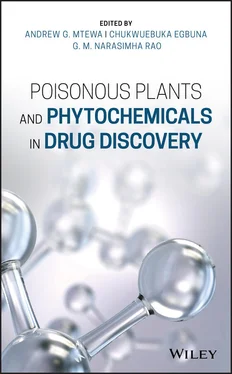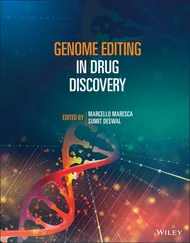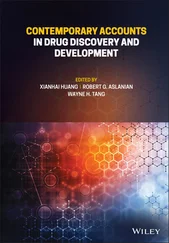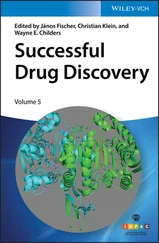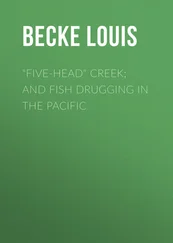1 Cover
2 Title Page Poisonous Plants and Phytochemicals in Drug Discovery Edited by Andrew G. Mtewa Division of Biological Chemistry and Drug Discovery, WCAIR, School of Life Sciences, University of Dundee, Dundee, UK Chemistry Section, Malawi Institute of Technology, Malawi University of Science and Technology, Limbe, Malawi Pharmbiotechnology and Traditional Medicine Center (PHARMBIOTRAC), Department of Pharmacology, School of Medicine, Mbarara University of Science and Technology, Mbarara, Uganda Chukwuebuka Egbuna Department of Biochemistry, Faculty of Natural Sciences, Chukwuemeka Odumegwu Ojukwu University, Uli, Anambra State, Nigeria Nutritional Biochemistry and Toxicology Unit, World Bank Africa Centre of Excellence, Centre for Public Health and Toxicological Research (ACE‐PUTOR), University of Port Harcourt, Port Harcourt, Rivers State, Nigeria G.M. Narasimha Rao Department of Botany, Andhra University, Visakhapatnam, Andhra Pradesh, India
3 Copyright Page
4 List of Contributors
5 List of Figures
6 List of Tables
7 Preface
8 Editors
9 1 Historical Use of Toxic Plants 1.1 Introduction to Toxic Plants 1.2 Poisonous Plants as Sources of Traditional and Modern Medicines 1.3 Toxic Plants and Justice 1.4 Toxic Plants in Poisoned Weapons 1.5 Plant Fishing Poisons/Piscicides/Ichthyotoxins 1.6 Poisonous Plants as Food 1.7 Poisonous Plants as Biopesticides 1.8 Toxic Psychoactive Plants for Recreational and Religious Purposes 1.9 Poisonous Plants in Warfare and Bioterrorism 1.10 Poisonous Plants as Carcinogens and Teratogens 1.11 Conclusion References
10 2 Classification of Phytotoxins and their Mechanisms of Action 2.1 Introduction 2.2 Possible Categorization 2.3 Currently Available Classification Tools 2.4 Role of Phytotoxin Classification 2.5 Brief Mechanisms of Action 2.6 Conclusion References
11 3 Poisonous Plants as Sources of Anticancer and Other Drugs 3.1 Introduction 3.2 Poisonous Plants in the Treatment of Cancer and Other Diseases 3.3 Poisonous Plant‐Based Anticancer Drugs that are on the Market 3.4 Poisonous Plant‐Based Drugs Against Other Diseases that are on the Market 3.5 Conclusion References
12 4 Drugs in Clinical Practice from Toxic Plants and Phytochemicals 4.1 Introduction 4.2 Drugs in Clinical Practice from Toxic Plants References
13 5 Toxicology and Health Benefits of Plant Alkaloids 5.1 Introduction 5.2 Pharmacological Properties of Alkaloids 5.3 Toxicological Properties of Alkaloids 5.4 Acute and Chronic Toxicities 5.5 Factors that Influence the Toxicological Profile of Alkaloids 5.6 Conclusion References
14 6 Chemical and Pharmacological Mechanisms of Plant‐Derived Neurotoxins 6.1 Introduction 6.2 Nerve Agents 6.3 Chemical Mechanisms of Neurotoxicity Induced by Organophosphate Nerve Agents 6.4 Mustards 6.5 Plant Natural Neurotoxins 6.6 Plant Glycosides 6.7 Conclusion References
15 7 Phytosedatives for Drug Discovery 7.1 Introduction 7.2 Treatment of Neuropsychological Disorders: The Current Scenario 7.3 Phytosedatives: Desirable Alternatives to Synthesized Drugs 7.4 Different Classes of Phytosedatives 7.5 Plants with Reported Sedative Actions 7.6 Conclusion References
16 8 Mushroom Species and Classification 8.1 Introduction 8.2 Classification of Mushrooms 8.3 Bioactive Agents in Mushroom Species 8.4 Bioactive Agents in Non‐Edible Mushroom Species 8.5 Other Bioactive Compounds of Mushroom Species 8.6 Conclusion References
17 9 Toxicity Protocols for Natural Products in the Drug Development Process 9.1 Introduction 9.2 In Vitro Toxicity Testing for Natural Products 9.3 Methods Used for In Vitro Toxicity Studies 9.4 In Vitro Models for Liver Toxicity 9.5 In Vitro Models for Nephrotoxicity Studies 9.6 In Vitro Model for Dermal Toxicity Testing 9.7 Mutagenicity Testing In Vitro 9.8 Reproductive and Teratogenicity Studies In Vitro 9.9 In Vivo Toxicity Testing of Natural Products 9.10 Conclusion References
18 10 Quality Control for the Safety of Natural Products 10.1 Introduction 10.2 Quality Assurance of Herbal Products 10.3 Methods of Quality Control for Herbal Products 10.4 WHO Guidelines for Quality Standardization of Herbal Formulations 10.5 Concept of Validation in Herbal Products 10.6 Challenges Related to Quality Control and Monitoring the Safety of Herbal Products References
19 11 Secondary Metabolites and Toxins of Microbial Origin for the Treatment of Diseases 11.1 Introduction 11.2 Antimicrobial Agents from Microbial Sources 11.3 Antifungal Agents from Microbial Sources 11.4 Anticancer Agents from Microbial Sources 11.5 Hypocholesterolemic Agents from Microbial Sources 11.6 Immunosuppressants from Microbial Sources 11.7 Enzyme Inhibitors from Microbial Sources 11.8 Antiparasitic Agents from Microbial Sources 11.9 Recent Advances in Drug Discovery from Microbial Sources References
20 12 Development of Phyto‐Antidotes Against Adverse Chemical Agents 12.1 Introduction 12.2 Heavy Metals and their Effects on the Body 12.3 Detoxification Properties of Biologically Active Substances of Plant‐Based Foods 12.4 Current State of Clinical Application of Phyto‐Antidotes 12.5 Further Prospects in the Search for Promising Phyto‐Antidotes 12.6 Conclusions References
21 13 Nanoformulated Herbal Drug Delivery as Efficient Antidotes Against Systemic Poisons 13.1 Introduction 13.2 Herbal Phytochemicals as Antidotes for Systemic Poisons 13.3 Nanoformulated Herbal Phytochemicals as Antidotes 13.4 Mechanism of Nanoformulated Herbal Phytochemicals against Systemic Poisoning 13.5 Future Perspectives 13.6 Conclusion References
22 14 Phytochemical‐Based Nanoparticles as Foes and Friends 14.1 Introduction 14.2 Phytochemicals Used in the Synthesis of Nanoparticles 14.3 Anti‐Inflammatory Effects of Nanoparticles 14.4 Wound‐Healing Effects of Nanoparticles 14.5 Antiparasitic, Antifungal, and Antibacterial Activities of Nanoparticles 14.6 Neuroprotective Effects of Nanoparticles 14.7 Cardioprotective Effects of Nanoparticles 14.8 Anticancer Effects of Nanoparticles 14.9 Advantages of Nanoparticles 14.10 Disadvantages of Nanoparticles 14.11 Conclusion and Future Directions References
23 15 Application of Metabolomics in Emergency Phytochemical Poisoning and Remediation 15.1 Introduction 15.2 Traditional Use of Medicinal Plants 15.3 Natural Products: Safety and Toxicity 15.4 Biological Systems in Phytochemical Poisoning and Remediation 15.5 Metabolomics: An Important Functional Genomics Tool 15.6 Assessment of Toxicity of Herbal Medicines Using Metabolomics 15.7 Application of Metabolomics in Emergency Phytochemical Poisoning and Remediation 15.8 Conclusion References
24 16 Methods for the Detection and Identification of Phytotoxins 16.1 Introduction 16.2 Phytotoxins 16.3 Methods Generally Used for Phytotoxin Detection 16.4 Protease Inhibition Detection Protocol 16.5 Isolation of Phytotoxins from Microorganisms 16.6 Conclusion References
25 17 Categorization, Management, and Regulation of Potentially Weaponizable Toxic Plants 17.1 Introduction 17.2 Management of Weaponized Natural Food Agents 17.3 Techniques Used for Extraction, Segregation, and Decontamination of Phytochemicals 17.4 Techniques for Identification of Bioactive Compounds 17.5 Types of Natural Phytotoxins 17.6 Conclusion References
26 18 In Silico Modeling as a Tool to Predict and Characterize Plant Toxicity 18.1 Introduction 18.2 Components of In Silico Toxicity Methods 18.3 Modeling Methods 18.4 Structural Alerts/Rule Based 18.5 Statistical Structure‐Based Activity Relationship Models 18.6 Conclusion References
27 Index
28 End User License Agreement
1 Chapter 1 Table 1.1 Some common drugs derived from toxic plants.
2 Chapter 3 Table 3.1 Selected poisonous plants from around the world.Table 3.2 Drugs from poisonous plants used as anticancer agents.Table 3.3 Some examples of drugs developed from poisonous plants.
Читать дальше
